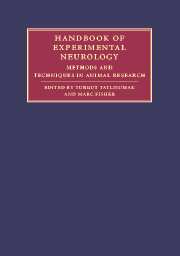Book contents
- Frontmatter
- Contents
- List of contributors
- Part I Principles and general methods
- Part II Experimental models of major neurological diseases
- 18 Focal brain ischemia models in rodents
- 19 Rodent models of global cerebral ischemia
- 20 Rodent models of hemorrhagic stroke
- 21 In vivo models of traumatic brain injury
- 22 Experimental models for the study of CNS tumors
- 23 Experimental models for demyelinating diseases
- 24 Animal models of Parkinson's disease
- 25 Animal models of epilepsy
- 26 Experimental models of hydrocephalus
- 27 Rodent models of experimental bacterial infections in the CNS
- 28 Experimental models of motor neuron disease/amyotrophic lateral sclerosis
- 29 Animal models for sleep disorders
- 30 Experimental models of muscle diseases
- Index
- References
24 - Animal models of Parkinson's disease
Published online by Cambridge University Press: 04 November 2009
- Frontmatter
- Contents
- List of contributors
- Part I Principles and general methods
- Part II Experimental models of major neurological diseases
- 18 Focal brain ischemia models in rodents
- 19 Rodent models of global cerebral ischemia
- 20 Rodent models of hemorrhagic stroke
- 21 In vivo models of traumatic brain injury
- 22 Experimental models for the study of CNS tumors
- 23 Experimental models for demyelinating diseases
- 24 Animal models of Parkinson's disease
- 25 Animal models of epilepsy
- 26 Experimental models of hydrocephalus
- 27 Rodent models of experimental bacterial infections in the CNS
- 28 Experimental models of motor neuron disease/amyotrophic lateral sclerosis
- 29 Animal models for sleep disorders
- 30 Experimental models of muscle diseases
- Index
- References
Summary
Introduction
Parkinson's disease (PD) is a progressive neurodegenerative disorder characterized primarily by the gradual dopaminergic loss in the substantia nigra of the midbrain region. Development of PD can be sporadic or can be associated with genetic mutations and deficiencies, or may result from the combination of these two precipitating factors. The pathogenesis of PD has been studied in numerous experimental models developed to replicate the salient features of the disease in a controlled environment. Although no single model exists today that mimics all the neurological and neuropathological features of PD, each model presents a particular aspect of the disease process induced either by natural or artificial toxic agents or by genetically induced deficiencies in experimental animals. Epidemiological and laboratory results suggest that environmental factors play a predominant role in the induction and propagation of dopaminergic degeneration. However, numerous familial cases indicate that development of PD might be aggravated by pre-existing genetic deficiencies that act as predisposing factors. This chapter describes in detail the extensive research conducted using animal and tissue-culture models of Parkinson's disease induced by both toxins and genetic manipulation. Furthermore, salient experimental findings are thoroughly described with regard to current perspectives on neurotoxic mechanisms of genetic variations and environmental toxins.
6-Hydroxydopamine model of PD
6-Hydroxydopamine (6-OHDA) was first demonstrated to effectively replicate Parkinsonian neurotoxic pathology in rats by stereotaxic nigral injection in rats as early as 1975.
- Type
- Chapter
- Information
- Handbook of Experimental NeurologyMethods and Techniques in Animal Research, pp. 411 - 437Publisher: Cambridge University PressPrint publication year: 2006



